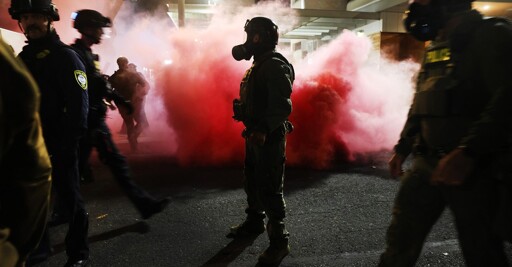Throughout Donald Trump’s 2024 campaign for the presidency, he repeatedly indicated his desire to deploy National Guard troops into the “crime dens” of American cities and against the “enemy within.” This promise, at least, he has kept. Over the past four months, the president has sent the Guard into the streets of Los Angeles and the District of Columbia. Now Trump is pushing to do the same in Portland, Oregon (which he recently described as “a burning hellhole”), and Chicago (“probably worse than almost any other city in the world”).
Trump’s eagerness to send troops into American cities is at odds with the country’s well-established antipathy toward domestic military deployments. In a ruling last week barring Trump’s deployment of the Oregon Guard into Portland, Judge Karin Immergut of the U.S. District Court for the District of Oregon wrote that the United States “has a longstanding and foundational tradition of resistance to government overreach, especially in the form of military intrusion into civil affairs.” Trump’s arguments for deploying the Guard “risk blurring the line between civil and military federal power,” the judge warned. Likewise, at a press conference yesterday, Illinois Governor J. B. Pritzker, a Democrat, argued that Trump “wants to justify and normalize the presence of armed soldiers under his direct command.” Trump’s deployments of the National Guard, while clumsy, are best understood as an effort to erode the nation’s sense that such use of the military is unacceptable. In doing so, he would also erode what remains of America’s cultural bulwark against tyranny.
“Dangerous cities,” Trump told a gathering of generals at Quantico last week, should be used as “training grounds for our military.” If more National Guard service members end up patrolling the streets of yet more major American cities, it will be for exactly one reason: The president wants to see them there.
Plans for the National Guard’s arrival into Chicago and Portland have been less than smooth. Trump began musing about sending troops into Chicago in late August, then suggested that he would “wait to be asked” by Pritzker. Later Trump reversed course again, posting on Truth Social, “Chicago about to find out why it’s called the Department of WAR 🚁🚁🚁” along with an apparently AI-generated meme of himself crouched in front of a fiery Chicago skyline, labeled CHIPOCALYPSE NOW. In Portland, meanwhile, the president has attempted to shuffle around Guard troops from different states in an effort to bypass Immergut’s order.
The National Guard is a shape-shifting creature of American federalism, descending from state militias at the time of the country’s founding. Each state’s National Guard can be deployed as a militia under the control of the governor. If federalized by the president, the Guard can become part of the nation’s armed forces under Title 10 of the U.S. code—an authority most commonly used for deploying National Guard service members abroad. Or they can operate in a hybrid status where they follow their governor’s orders but carry out a federal mission. This last option is known as Title 32, after the relevant section of the U.S. code, and is often used for training and functions such as disaster relief.
[Quinta Jurecic: Trump’s farcical D.C. crackdown]
These distinctions have operational significance in terms of how troops are mobilized and who pays the bill, but they also matter because of the legal constraints that follow from each status. Most important, if the National Guard is under federal control, the Posse Comitatus Act forbids the government from using those troops to carry out law-enforcement work. When Trump federalized the California National Guard to Los Angeles in response to anti-ICE protests this June, California Governor Gavin Newsom, another Democrat, argued that the troops were prohibited from helping immigration officials, for example by setting up road blocks or establishing perimeters. Early last month, Judge Charles Breyer, a federal judge in California, agreed with Newsom, holding that such immigration-enforcement assistance by the Guard constituted a violation of the law.
The administration quickly appealed Breyer’s ruling, but these legal concerns may have encouraged the White House to look for other ways to deploy troops in Chicago. For several weeks, instead of federalizing the Illinois Guard, Trump appeared to be flirting with the idea of getting Texas Governor Greg Abbott to send his National Guard—operating under Title 32 status—into Chicago, against Pritzker’s will. This would have the advantage of arguably allowing the Texas Guard to work with law enforcement without running afoul of the Posse Comitatus Act. But it would have the disadvantage of constituting an invasion of one sovereign state into another. (Red-state governors contributed National Guard units to Trump’s D.C. deployment under Title 32, but the District lacks the legal protections that Illinois has as a sovereign state.) The prospect of a skirmish between Illinois and Texas might have been too extreme even for Trump.
The president seems to have backed away from that potential crisis. Instead, in both Portland and Chicago, he adopted his original California strategy—despite the risk of more lawsuits alleging violation of the Posse Comitatus Act. First, he dialed up ICE’s presence in both cities, generating protests—some quite minor—in response. Then, he federalized the National Guards of both states to take them out of the hands of their Democratic governors, and send in troops to quell the supposed disorder caused by the protesters. Earlier this week, after Immergut barred the federal government from deploying the Oregon Guard to Portland under Title 10, the Defense Department scrambled to send in the handful of California Guard troops still under federal control in L.A. (Immergut blocked this as well.) In Chicago, another judge declined to bar the federalization of the Illinois Guard in advance of a Thursday court hearing. A federalized contingent of the Texas Guard may yet arrive in the city. It would be operating under Trump, not under Abbott—meaning that troops will be deployed by the federal government, rather than as invading forces from one state into another.
State and local officials in Oregon and Illinois have all emphasized the overwhelming peacefulness of the cities now under threat and the needlessness of any deployment. In late September, Trump seemed to give voice to a glimmer of doubt as to whether Portland really is the hellscape he had previously noted: “Am I watching things on television that are different from what’s happening?” But that glimmer appears to have faded, as Trump continues to insist that both cities are lawless wastelands in need of the firm hand of the military. So far, no one outside the administration appears particularly convinced. Immergut’s initial ruling described the anti-ICE protests in Portland as “small and uneventful” and derided the government’s hellish depiction of the city as “simply untethered to the facts.” At his press conference yesterday, Pritzker accused Trump of engineering the supposed disorder in Chicago himself so as to generate an excuse for deploying troops.
[Christopher Purdy: What we lose by distorting the mission of the National Guard]
In the absence of any factual justification, the legal justifications can be mixed and matched, from federalized status to Title 32 and back again. So, too, can the different Guard units: Oregon or California? The administration does not seem to have a strong preference. “The sole objective is to get some number of National Guard personnel to Portland or to Chicago, and they could not care less what their duty status is or how many of them there are,” Chris Mirasola, a University of Houston law professor who previously served in the Defense Department’s Office of General Counsel during the first Trump administration and the Biden administration, told me. “That is the only way I can make sense of why they keep trying something new every couple of hours.”
Mirasola pointed to the scanty numbers of Guard troops actually being deployed—a few hundred from Oregon, Illinois, and Texas, compared with the thousands that patrolled D.C. and Los Angeles. If the goal is to restore order to an anarchic city, that’s very few troops indeed. If the goal is a threatening photo shoot featuring men with guns and camouflage uniforms, 200 or 300 is more than enough.
There is one tool that Trump hasn’t yet picked up: the Insurrection Act. This authority creates an exception to the Posse Comitatus Act, allowing the military to play a law-enforcement role in the case of insurrection or rebellion. Trump seemed intrigued with the idea of invoking the statute during his first term, and his supporters reportedly developed plans to exploit the law in preparation for his second. He has so far avoided it in favor of the odd work-arounds now on display in Portland and Chicago. But the administration may be inching closer. Speaking to reporters in the Oval Office yesterday, he suggested that he might consider wielding the statute “if people were being killed and courts were holding us up, or governors or mayors were holding us up.” In a Newsmax interview later last night, Trump described Portland as in a state of “pure insurrection.” The president’s close adviser Stephen Miller excoriated judges who have ruled against the administration as engaging in “an insurrection against the laws and Constitution of the United States.”
The Insurrection Act is less ominous than it sounds—it doesn’t create new powers for the military, but rather allows service members to enforce preexisting laws. Still, its use carries a particular taboo, in significant part because of Americans’ cultural revulsion at seeing the military on the country’s streets. As with so many other American traditions, Trump has now set himself to the task of breaking this one down.
From The Atlantic via this RSS feed


